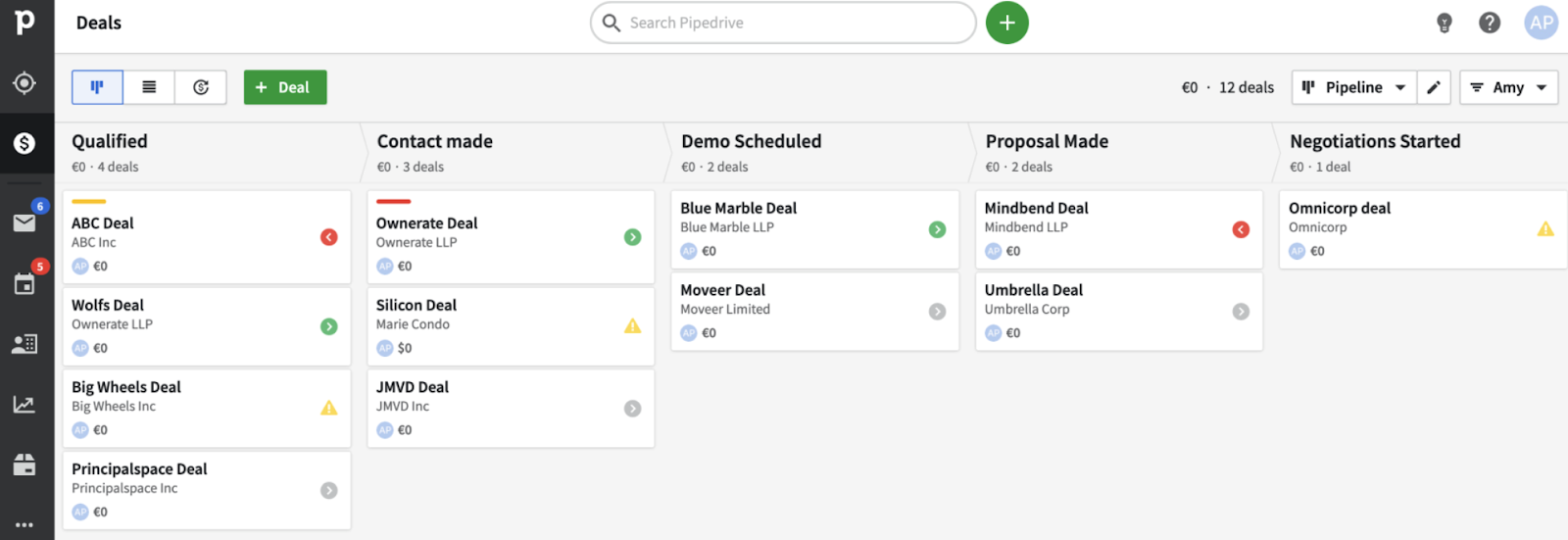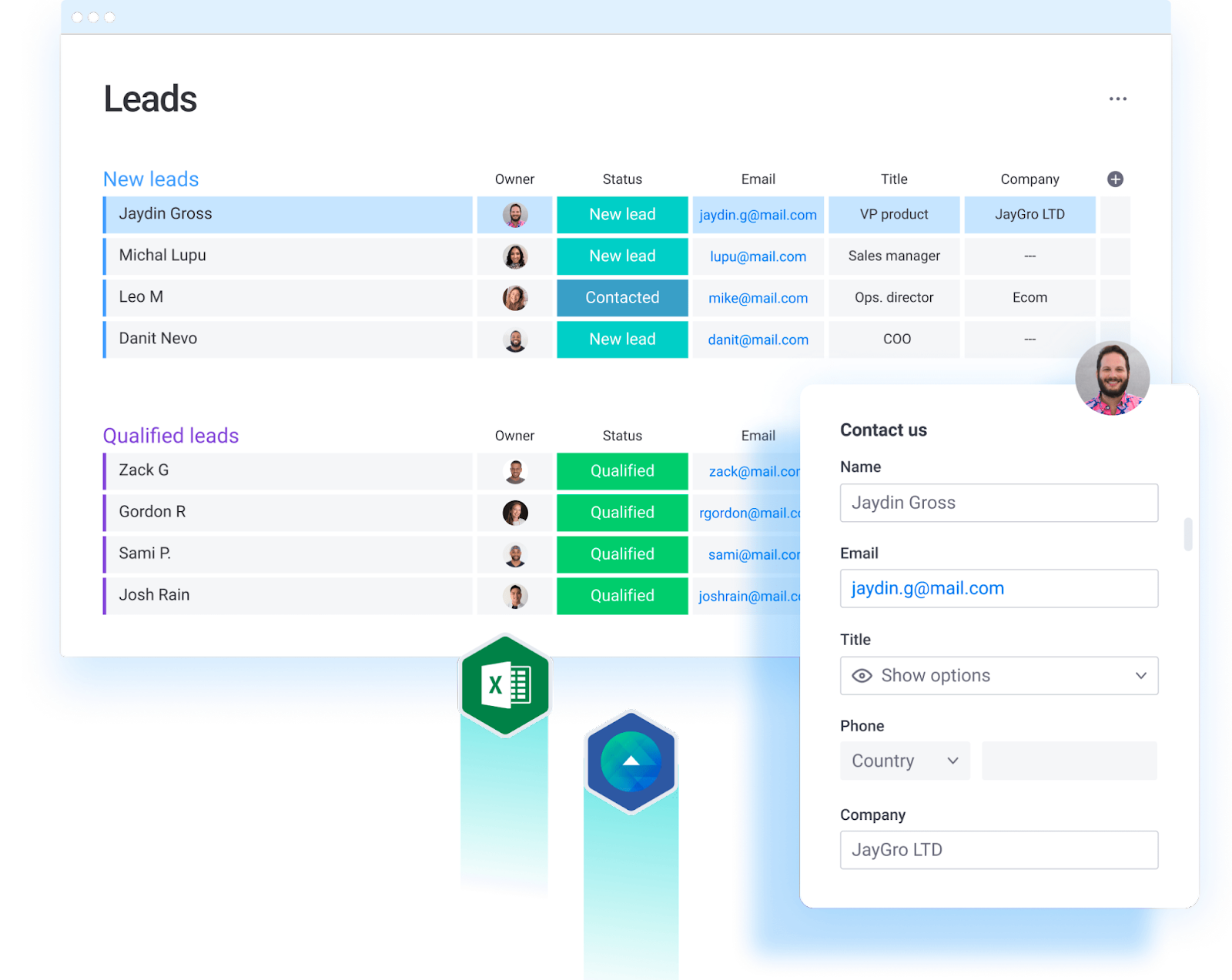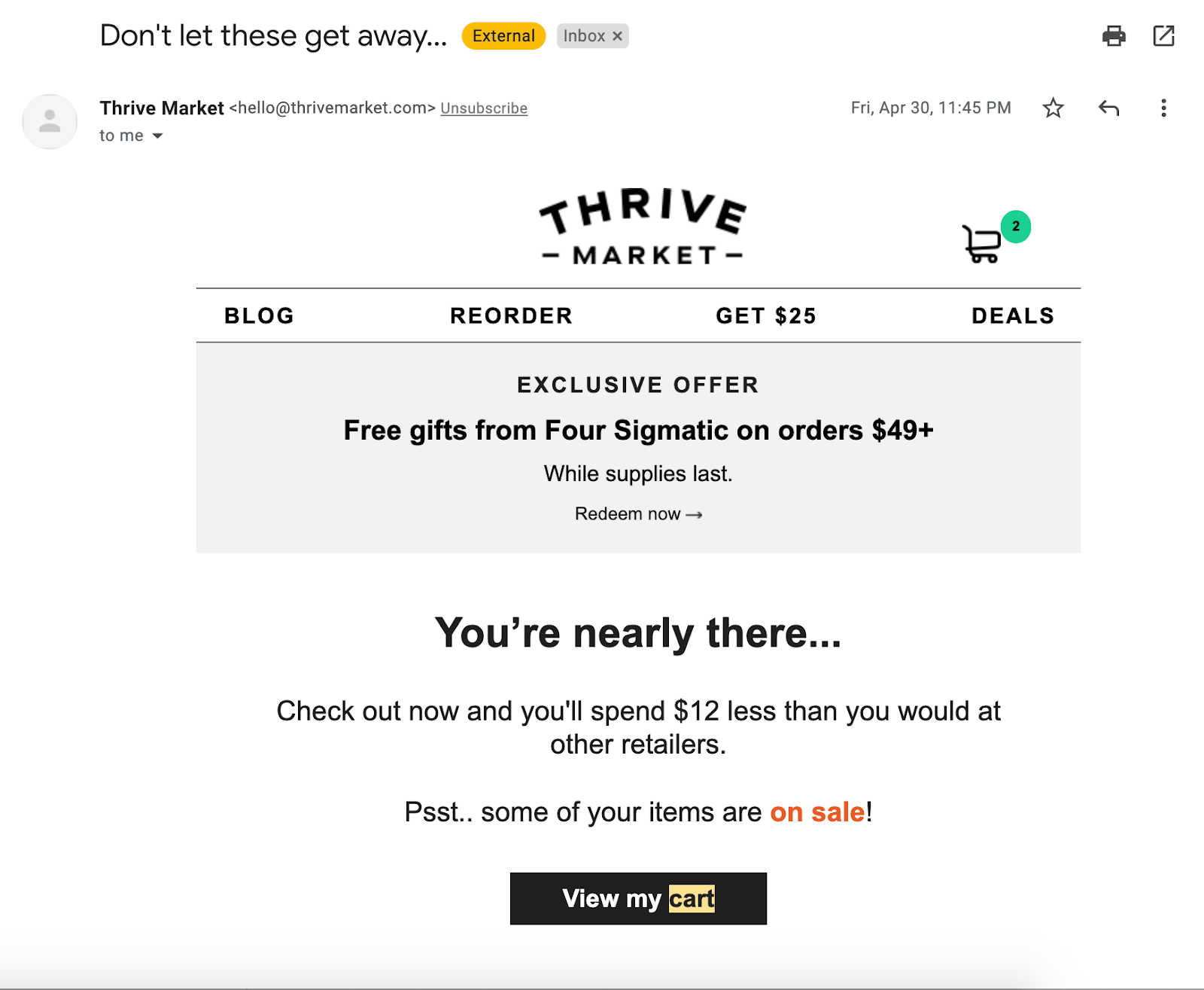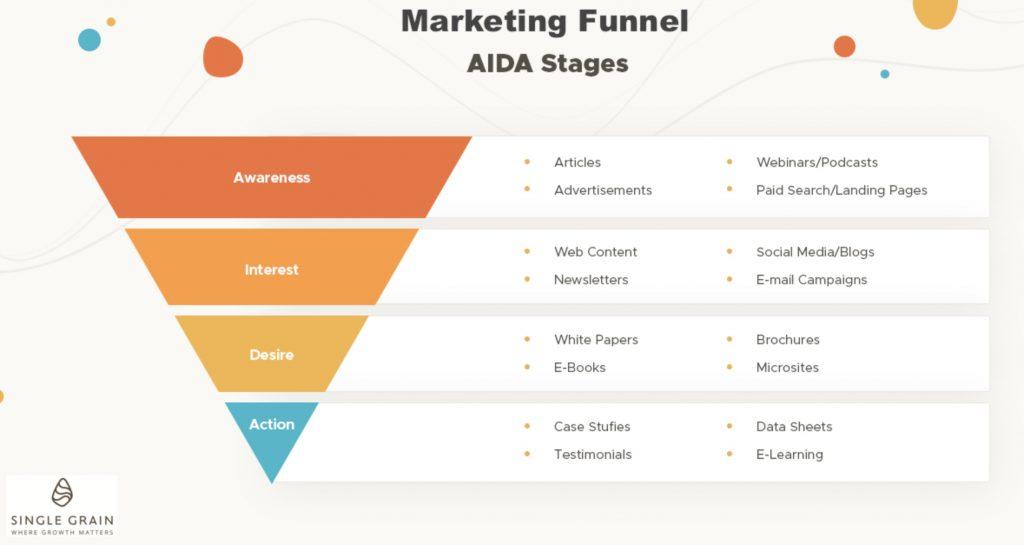At first glance, CRM and marketing automation may seem pretty similar.
But in reality, they serve two fundamentally different purposes. CRM software focuses on sales, while marketing automation software, fittingly, focuses on marketing efforts.
Here’s a detailed breakdown of their differences, along with how you can make them work together.
What is a CRM?
Short for customer relationship management, CRM is a software platform that helps you:
- Store customer contact information
- Manage communications
- Build rapport with customers
- Streamline sales processes
While products of the past tended to mainly focus on the customer database side of things, modern tools provide end-to-end solutions.
“CRM tools can now be used to manage customer relationships across the entire customer lifecycle, spanning sales, digital commerce, and customer service interaction,” Salesforce explains.
“A CRM solution helps you focus on your organization’s relationships with individual people — including customers, service users, colleagues, or suppliers — throughout your lifecycle with them, including finding new customers, winning their business, and providing support and additional services throughout the relationship.”
In other words, today’s customer relationship management software is extremely robust and consolidates a ton of sales team tasks into one convenient platform.
Everything from scheduling sales calls and emails to setting up meetings to offering quotes and upsells can be done with a CRM. This, in turn, translates into better service and less time wasted on tedious manual tasks.
In terms of top platforms, Business News Daily ranks the following as the top five, including Monday.com, Pipedrive, and HubSpot Marketing Hub depending on the specific business needs.

Source: Business News Daily
If, for example, managing your sales pipeline is your number one goal, Pipedrive lets you do it from a single, intuitive interface. That way you always have a bird’s-eye view of which leads are qualified, who’s been contacted, who’s scheduled a demo, and so on.

_Source: Pipedrive _
Another great product not featured on the list is Microsoft Dynamic CRM which has a wide array of innovative features and outstanding customer service.
What Are the Benefits of a CRM?
When used correctly, there are three key benefits of customer relationship management software.
Also Read: Marketing Automation Examples
First, it enables you to create an efficient, up-to-date customer database.
While managing a handful of customers for a small business may be fairly straightforward, things can get complicated in a hurry when you’re talking about dozens or hundreds of customers.
CRM automation allows you to store and manage critical information, enabling team members to find what they’re looking for quickly.
With Monday.com, for instance, you can maintain full transparency of your contacts and see key information like:
- New vs qualified leads
- Business owner
- Company
- Lead status
- Lead email
- Lead title

Source: Monday.com
Next, this platform sets the stage for better customer service, which, by default, leads to better relationships.
Try to put yourself in a customer’s shoes for a second.
Say one account rep uses a CRM platform, which allows them to:
- Know whether someone is a new lead, sales qualified lead, or existing customer
- Send timely messages
- Contact leads and customers using their preferred outreach channel (email, phone, etc.)
- Use personalized email marketing automation templates
Another rep, however, doesn’t use a CRM system and, as a result:
- Uses a cluttered, disorganized, out-of-date customer database
- Performs outreach at random regardless of lead status
- Uses whatever outreach method they prefer rather than what the lead or customer prefers
Which do you think sets the stage for the best relationship? Using a CRM, of course.
When you combine an efficient, up-to-date customer database and stronger relationships, it leads to the final key benefit — increased profits.
Research has found CRM has an average ROI of $8.71 for every dollar spent, increases collective sales revenue by as much as 29%, and boosts individual salesperson revenue by up to 41%.
Optimize for Conversion & ROAS Now! Explore Woopra in a demo and enjoy a 2-week free trial: https://www.woopra.com/demo
What Is Marketing Automation?
Simply put, this marketing software automates onerous, manual inbound marketing campaign tasks that have, in the past, been time-consuming.
“Marketing departments can automate repetitive tasks such as email marketing, social media posting, and even ad campaigns — not just for the sake of efficiency, but also to provide a more personalized experience for their customers,” HubSpot explains.
This graphic illustrates the full range of tasks that can be automated with marketing automation software.

Source: Single Grain
To accomplish this, your marketing team creates workflows where tasks are performed according to a set of instructions based on lead behavior.
Say, for example, a potential B2B customer signs up for a product demo. With marketing automation integration, they might receive a personalized message based on the particular product they’re interested in, along with links to relevant blog posts.
Or, say an e-commerce lead adds an item to their shopping cart but doesn’t complete the purchase. A personalized email could automatically be sent to remind them, along with a special offer such as an incentive.

Source: Tailwind
With marketing automation software, tasks are streamlined to clear up more time for your marketing team so they don’t have to engage in monotonous, redundant tasks. And the built-in analytics many platforms have offer additional insights to help your marketing team continually refine operations.
At the same time, leads get exactly what they need when they need it for a highly personalized experience and a better overall marketing campaign.
If you want to know about specific MA software, here’s a list of the best marketing automation tools today.
What Are the Benefits of Marketing Automation?
Marketing teams win in three main ways with this software.
Perhaps the most obvious benefit is the increased efficiency. Rather than engaging in a plethora of, what have historically been time-consuming tasks, such as email marketing and social media messaging, these tasks can be automated, which saves a ton of time.
To quantify, productivity increases by an average of 14.5% after implementing a marketing automation tool.
Second, it increases profitability.
Given the significant spike in productivity and the ability for a marketing team to accomplish far more in less time, it’s not surprising that profitability will increase as well.
In fact, that’s the number one reason why 80% of marketers use automation software in the first place, with new sales opportunities rising by an average of 20%.
Third, it often leads to greater customer satisfaction.
While there have certainly been cases where marketing activity has become “over automated,” customers are usually better off because:
- Marketing teams can reach a higher volume of customers more quickly
- It allows for a higher level of personalization
- The potential for human error is reduced
So when you look at it under this lens, it’s easy to see how the customer experience can improve with automation software.
What Is the Difference Between CRM and Marketing Automation?
Customer relationship management and a marketing automation solution differ in two main ways.
One is that CRM is primarily sales-oriented, while marketing automation software is marketing-centric.
Customer relationship management deals with effectively handling leads and converting them into customers, as well as maintaining strong relationships with existing customers.
A marketing automation platform, on the other hand, focuses exclusively on generating leads and moving them from the awareness stage at the top of the B2B marketing funnel down to interest, desire, and ultimately action.

Source: Influencer Marketing Hub
But that’s where it ends. Once someone has become a customer, there’s not much need for marketing automation software unless you’re doing something like sending automatic upsells in an email campaign.
The other big difference between CRM vs marketing automation software is that they’re used at different stages of the customer journey.
Marketing automation software is used at the beginning stages of the customer journey where you’re looking to turn raw leads into viable leads, viable leads into nurtured leads, nurtured leads into active leads, and active leads into marketing qualified leads.
At that point, CRM software takes over, turning marketing qualified leads into sales accepted leads, sales accepted leads into opportunities, and finally, opportunities into conversions.
This graphic from Capterra illustrates each of the stages perfectly.

Source: Capterra
In other words, marketing automation software is used at the top of the sales funnel and CRM software is used at the bottom of the sales funnel.
This brings us to our final point.
How Do CRMs and Marketing Automation Work Together?
At this point, we’ve established the key differences between CRMs and marketing automation platforms.
The final thing to discuss is how they work together to create a robust, end-to-end sales/marketing ecosystem.
I think Lacy Summers, CEO at Crush the PM Exam summarizes it perfectly with this quote.
“In tandem, marketing automation software feeds your CRM the detailed information it needs to provide all organizational units actionable insight into current and potential customers, what they want, what they don’t want, and how to serve them.”
As a result, this allows you to assess the unique needs and pain points of a lead and develop rapport before sending them to a sales rep. From there, the rep has detailed information, such as a lead score and knowledge of what types of content the lead is most receptive to.
The lead has also been “primed” by going through multiple touchpoints and likely has a considerable amount of trust with your brand.
Rather than being ice cold, as many leads who first enter the customer journey are, they’ve been warmed up and nurtured, which means they’re often ready for the sales conversation.
This combined with the sales team rep having a big picture view of the lead journey makes it much easier for them to talk about the right topics and focus on the optimal offerings to increase the chances of converting.
By using CRM and marketing automation features in conjunction with one another, it creates a seamless buyer journey and better marketing alignment for a more rewarding customer experience.
Wrapping Up
Sometimes a CRM system and marketing automation software are thought of as being siloed where there’s little to no overlap. A CRM is strictly used for sales and marketing automation is strictly used for marketing.
While there are substantial differences between the two, both play an integral role in customer relationship management and the overall sales process.
The key is to fully understand the applications of a CRM system and marketing automation system and how they converge to create a holistic sales funnel from beginning to end.
Doing so positions your sales team for maximum success and eliminates many friction points of the customer interaction process.




